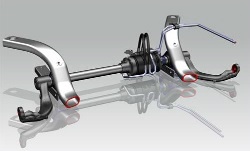JLR selects FIRESTONE & BWI
Date:Wed, October 30, 2013 , 8:56AM
New chassis technologies from BWI Group have been selected by JLR to help meet the design objectives of the new Range Rover Sport. The vehicle is equipped with BWI’s latest air suspension and lightweight active roll control (pictured) actuators to allow a combination of dynamic performance, refinement and off-road ability.
To meet Land Rover’s challenging design request, BWI worked with supplier Firestone to develop a new air sleeve for the company’s air suspension modules. A bespoke nylon-reinforced rubber compound was developed with exceptional hot and cold climate performance and the wall thickness was reduced to cut hysteresis. These changes, together with detailed component optimization to reduce friction, have helped achieve increased absorption of small road irregularities. To provide the protection and durability needed for off-road activities, the air sleeves are sheathed in an aluminum restraining guide. Weight has been reduced through careful design analysis and by increased use of aluminium.
The BWI actuators now offer 134° of rotation compared with 90° for the previous-generation system, helping Land Rover’s engineers deliver 260mm of wheel travel at the front and 272mm at the rear to further improve extreme off-road ability. The very high angular articulation also increases packaging flexibility, allowing a compact architecture that does not require intrusion into unrelated spaces. The system is also shorter than the previous generation system, thanks to a reduced ball screw length. Mass has been reduced by 2.4kg at the front and 2.2kg at the rear, largely through the use of hollow torsion bars with cast splined lever arms, also supplied by BWI.
BWI technology is also central to the Range Rover Sport’s new dynamic response system, which is calibrated to almost completely eliminate body roll at cornering forces up to 0.4g. The company is supplying elements of its active stabiliser bar system, including the all-important ball screw rotary actuators that provide roll-control torque up to 1,500Nm. When cornering forces are detected, the front and rear actuators apply a counter-acting rotational torque to the vehicle chassis via the cast lever arms of the stabiliser bar system. Independent control of the front and rear roll stiffness allows real-time optimisation of the oversteer /understeer characteristic, improving turn-in, comfort and safety.
Read the full article here on the Vehicle Dynamics International Magazine website:
http://www.vehicledynamicsinternational.com/news.php?NewsID=53244

